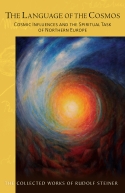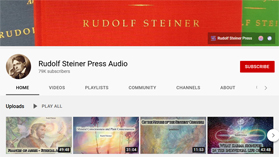
-
THE LANGUAGE OF THE COSMOS
Cosmic Influences and the Spiritual Task of Northern Europe
Rudolf Steiner

“Times have become serious; they have become so serious today that we must of necessity look upward from the narrowly defined events occurring within the limited horizon—which the majority of humanity prefers to recognize as the only legitimate one—to the cosmic expanses, also to the cosmic expanses of human soul-spiritual experiences. This is where we witness the cosmic turning point in time. If we become aware of this cosmic turning point in time, then we become aware that a cosmic New Year of the spirit must begin for humanity.”—Rudolf Steiner, New Year’s Eve lecture, 1921/22
This previously untranslated volume in The Collected Works of Rudolf Steiner comprises eleven lectures given to members of the Anthroposophical Society in Norway, Germany, and Switzerland in November and December of 1921. In Rudolf Steiner’s biography, 1921 was a year of many trials. These lectures stand between the earth-shattering years of the First World War and the tragic destruction of the First Goetheanum. Indeed, precisely one year after the final lecture published in this volume, the Goetheanum—the house of the Word to which Steiner devoted all his forces—burned to the ground in an act of arson.
Though separated geographically, the lectures share a common thematic thread: the need for modern humanity, freely and out of inner initiative, to learn once again the language of the cosmos. This theme is taken up strikingly in the lecture of December 18, 1921, in which Steiner describes the spiritual reality of the human being not in familiar anthroposophical terms as consisting of physical body, etheric body, astral body, and I, but rather imbues these otherwise abstract designations with inner content: the physical body is an echo of the active working of zodiacal forces, expressed as cosmic consonants, while the etheric body reveals an echo of the weaving of planetary spheres in the realm of the vowels. This interplay of the planetary forces in the vowels and the zodiacal forces in the consonants, which accompany the soul on its descent to earth, was once perceived instinctively by ancient humanity. It was understood that names are not given arbitrarily based on the whim of the parents but are designations that correspond to those planetary and zodiacal forces that played the greatest role in that individual’s path to earthly incarnation.
Abounding with penetrating insights, inspirations, and profound wisdom, this book speaks to all who seek a new understanding of humanity’s place in the universe.
27 September 2024; Trans. by Agnes Schneeberg-de Steur; (Eleven lectures held in Kristiania (Oslo), Berlin, Dornach, and Basel from November 24 to December 31, 1921. CW 209); SB; 209pp + 3 colour plates; 23.5 x 15.2 cm; pb;
£22.50 ISBN 9781621483427

